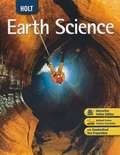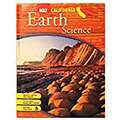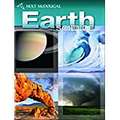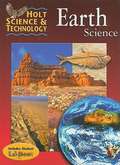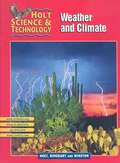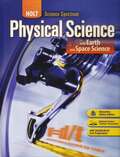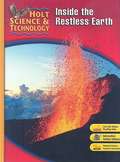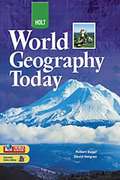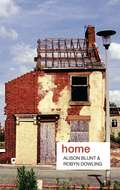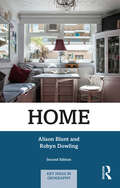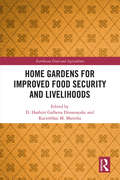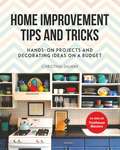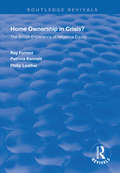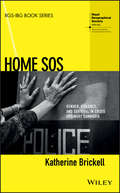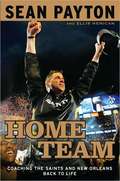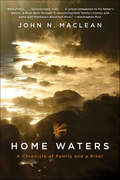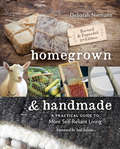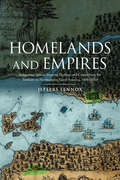- Table View
- List View
Holt Earth Science
by Jay M. Pasachoff Mead A. Allison Arthur T. DegatetanoThis text book on Earth Science contains unit lessons on Studying the Earth, Composition of the Earth, History of the Earth, The Dynamic Earth, Reshaping the Crust, Oceans, Atmospheric Forces and Space. Chapter Labs, Quick Labs, Maps in Action, Feature Articles are some of the additional features.
Holt Earth Science (California Edition)
by Holt Rinehart Winston StaffHolt Science California Grade 6 Earth organizes knowledge on the world we live in. Each chapter involves the learners taking them step by step through the exploration of science
Holt Mcdougal Earth Science
by Holt Mcdougal Allison Holt McDougalHolt Mcdougal Earth Science: Student Edition 2010
Holt Science & Technology: Earth Science
by Holt Rinehart WinstonThis book on Earth Science contains unit lessons of Introduction to Earth Science, Earth's Resources, The Restless Earth, Reshaping the Land, Oceanography, Weather and Climate, etc.
Holt Science & Technology: Earth Science, Reading Comprehension Guide
by Rinehart Winston Staff HoltNIMAC-sourced textbook
Holt Science & Technology: The Earth's Surface
by Holt Rinehart Winston Staff7th grade science textbook
Holt Science And Technology: Weather and Climate
by Holt Rinehart Winston StaffMiddle School Science
Holt Science Spectrum®: Physical Science with Earth and Space Science
by Ken Dobson John Holman Michael RobertsNIMAC-sourced textbook
Holt Science and Technology: Earth Science Reading Comprehension Guide
by Holt Rinehart Winston StaffHolt Science And Technology Earth Science: Reading Comprehension Guide
Holt Science and Technology: Inside the Restless Earth
by Holt Rinehart WinstonScience is a process of discovery, a trek into the unknown. The skills you develop using Holt Science & Technology--such as observing, explaining observations and ideas--are the skill you will need for the future. There is a universe of exploration and discovery awaiting those who accept the challenges of science.
Holt Science and Technology: Inside the Restless Earth
by Holt Rinehart WinstonLearn all you can about the inside of the earth in this book. Topics include: volcanoes, plate tectonics, minerals, rocks and fossil.
Holt World Geography Today
by Robert J. Sager David M. HelgrenThis geography textbook helps students make connections between what they learn in class and real events around the world today.
Holt World Geography Today (Texas Edition)
by Robert J. Sager David M. HelgrenDo you know why the loss of huge forest areas in one part of the world can affect areas far away? Why does the United States have many different kinds of churches and other places of worship? Perhaps you are curious why Americans and people from other countries have such different points of view on many issues. The key to understanding questions and issues like these lies in the study of geography.
Home (Key Ideas in Geography)
by Alison Blunt Robyn Dowling‘Home’ is a significant geographical and social concept. It is not only a three-dimensional structure, a shelter, but it is also a matrix of social relations and has wide symbolic and ideological meanings; home can be feelings of belonging or of alienation; feelings of home can be stretched across the world, connected to a nation or attached to a house; the spaces and imaginaries of home are central to the construction of people’s identities. An essential guide to studying home and domesticity, this book locates ‘home’ within wider traditions of thought. It analyzes different sources, methods and examples in both historical and contemporary contexts; ranging from homes on the American frontier and imperial domesticity in British India, to Australian suburbs, multicultural London, and South Asian diasporic homes. The core argument of the book has three main parts that cut across each of its chapters: home-making identity and belonging homely and unhomely spaces. Each chapter includes text boxes and exercises and is well illustrated with cartoons, line drawings, and photographs. Outlining the social relations shaping, (and being influenced by) the geographies of home; and the imaginative as well as material importance of home, this book will be a valuable reference for students of geography, sociology, gender studies, and those interested in the home and domesticity.
Home (Key Ideas in Geography)
by Alison Blunt Robyn DowlingHome articulates a ‘critical geography of home’ in which home is understood as an emotive place and spatial imaginary that encompasses lived experiences of everyday, domestic life alongside a wider, and often contested, sense of being and belonging in the world. Engaging with the burgeoning cross-disciplinary interest in home since the first edition was published, this significantly revised and updated second edition contains new research boxes, illustrations, and contemporary examples throughout. It also adds a new chapter on ‘Home and the City’ that extends the scalar understanding of home to the urban. The book develops the conceptual and methodological underpinnings of a critical geography of home, drawing on key feminist, postcolonial, and housing thinkers as well as contemporary methodological currents in non-representational thinking and performance. The book’s chapters consider the making and unmaking of home across the domestic scale – house-as-home; the urban – city-as-home; national – nation-as-home; and homemaking in relation to transnational migration and diaspora. Each chapter includes illustrative examples from diverse geographical contexts and historical time periods. Chapters also address some of the key cross-cutting dimensions of home across these scales, including digital connectivity, art and performance, more-than-human constructions of home, and violence and dispossession. The book ends with a research agenda for home in a world of COVID-19. The book provides an understanding of home that has three intersecting dimensions: that material and imaginative geographies of home are closely intertwined; that home, power, and identity are intimately linked; and that geographies of home are multi-scalar. This framework, the examples used to illustrate it, and the intended audience of academics and students across the humanities and social sciences will together shape the field of home studies into the future.
Home Gardens for Improved Food Security and Livelihoods (Earthscan Food and Agriculture)
by D. Hashini Galhena Dissanayake Karimbhai M. MarediaHome Gardens for Improved Food Security and Livelihoods demonstrates how home gardens hold particular significance for resource-poor and marginalized communities in developing countries, and how they offer a versatile strategy toward building local and more resilient food systems.With food and nutritional security being a major global challenge, there is an urgent need to find innovative ways to increase food production and diversify food sources while increasing income-generating opportunities for communities faced with hunger and poverty. This book shows that when implemented properly, home gardens can become just such an innovative solution, as well as an integral part of sustainable food security programs. It provides a conceptual overview of social, economic, environmental and nutritional issues related to home gardening in diverse contexts, including gender issues and biodiversity conservation, and presents case studies from Africa, Asia and Latin America highlighting home gardening experiences and initiatives. The volume concludes with a synthesis of key lessons learned and ways forward for further enhancing home gardens for sustainable food security and development.This book will be a useful read for students and scholars working on local food systems, food security, sustainable development and more broadly development strategy.
Home Improvement Tips and Tricks: Hands-on Projects and Decorating Ideas on a Budget
by Christina SalwayStep-by-Step Projects from a Successful and Sassy Interior Designer!Searching for a house or apartment is difficult enough on its own; transforming it into your home is an entirely different story. Home Improvement Tips and Tricks aims to give you the knowhow to decorate while staying within your budget, all presented in an engaging and approachable way. Each project is accompanied by a list of tools and materials needed, along with step-by-step instructions. Salway’s wit and playful personality shine through as she shares her tried-and-true advice to describe the journey of renovating and redecorating not only her two-bedroom Williamsburg apartment but also the upstate New York farmhouse bought as a major fixer-upper. Some of Christina’s greatest lessons include: Colors you shouldn’t paint your apartment, even if you like wearing them Where to look, when to haggle, and how to spot a diamond in the rough How to revitalize your kitchen on a budget Your shower curtain shouldn’t reflect your personality, and other helpful bathroom hints How to install a dimmer switch (a.k.a. instant mood lighting) A resource for anyone who is short on time and strapped for cash, Home Improvement Tips and Tricks will help you turn any space into a unique home you love and are proud to show off.
Home Ownership in Crisis?: The British Experience of Negative Equity (Routledge Revivals)
by Ray Forrest Patricia Kennett Philip LeatherFirst published in 1999, this book brings together the findings from research projects funded by the Joseph Rowntree Foundation and the Department of the Environment, Transport and the Regions. The programme of research examined the problems faced by home owners with the collapse of the property market in the late 1980s. The book focuses on households with negative equity and uses analyzes of secondary data sets, social surveys and in-depth interviews to explore the implications of the fall in property values for both households and the wider economy. In particular it examines the kinds of coping strategies adopted by home owners in relation to debt and mobility. Home Ownership in Crisis? thus gets beyond aggregate estimates and offers the reader a detailed understanding of what negative equity actually means for the individuals concerned. Moreover, by exposing a range of circumstances in which negative equity arises, the book also informs debates about the kinds of policy initiatives which may be appropriate in dealing with a more volatile economic environment in Britain and elsewhere.
Home SOS: Gender, Violence, and Survival in Crisis Ordinary Cambodia (RGS-IBG Book Series)
by Katherine BrickellDrawing on 15 years of fieldwork and over 300 interviews, Home SOS argues that the home is central to the violence and gendered contingency of existence in crisis ordinary Cambodia. Provides an original book-length study which brings domestic violence and forced eviction into twin view Offers relational insights between different violences to build an integrated understanding of women’s experiences of home life Mobilises the crisis ordinary as a critical pedagogy and imaginary through which to understand everyday gendered politics of survival Positions domestic violence and forced eviction as manifestations of intimate war against women’s homes and bodies located inside and outside of the traditional purview of war Reaffirms and reprioritises the home as a political entity which is foundational to the concerns of human geography
Home Team: Coaching the Saints and New Orleans Back to Life
by Sean Payton Ellis HenicanA story of a city recovering from disaster of Hurricane Katrina and a team with a history of heartbreak. The inspirational true story tells how one man led a football team-- and a city-- to triumph in Super Bowl XLIV.
Home Waters: A Chronicle of Family and a River
by John N. Maclean“Beautiful. ... A lyrical companion to his father’s classic, A River Runs through It, chronicling their family’s history and bond with Montana’s Blackfoot River.” —Washington PostA "poetic" and "captivating" (Publishers Weekly) memoir about the power of place to shape generations, Home Waters is John N. Maclean's remarkable chronicle of his family's century-long love affair with Montana's majestic Blackfoot River, the setting for his father's classic novella, A River Runs through It. Maclean returns annually to the simple family cabin that his grandfather built by hand, still in search of the trout of a lifetime. When he hooks it at last, decades of longing promise to be fulfilled, inspiring John, reporter and author, to finally write the story he was born to tell. A book that will resonate with everyone who feels deeply rooted to a landscape, Home Waters is a portrait of a family who claimed a river, from one generation to the next, of how this family came of age in the 20th century and later as they scattered across the country, faced tragedy and success, yet were always drawn back to the waters that bound them together. Here are the true stories behind the beloved characters fictionalized in A River Runs through It, including the Reverend Maclean, the patriarch who introduced the family to fishing; Norman, who balanced a life divided between literature and the tug of the rugged West; and tragic yet luminous Paul (played by Brad Pitt in Robert Redford’s film adaptation), whose mysterious death has haunted the family and led John to investigate his uncle’s murder and reveal new details in these pages.A universal story about nature, family, and the art of fly fishing, Maclean’s memoir beautifully captures the inextricable ways our personal histories are linked to the places we come from—our home waters. Featuring twelve wood engravings by Wesley W. Bates and a map of the Blackfoot River region.
Homegrown & Handmade: A Practical Guide to More Self-Reliant Living
by Deborah NiemannThe author of Ecothrifty shows you how to life more self-sufficiently with her guide to modern homesteading―no farm required.Food recalls, dubious health claims, scary and shocking ingredients in health and beauty products. Our increasingly industrialized supply system is becoming more difficult to navigate, more frightening, and more frustrating, leaving us feeling stuck choosing in many cases between the lesser of several evils. That&’s why author Deborah Niemann is here to offer healthier, more empowering choices, by showing us how to reclaim links in our food and purchasing chains, to make choices that are healthier for our families, ourselves, and our planet.In this fully updated and revised edition of Homegrown and Handmade, Deborah shows how making things from scratch and growing some of your own food can help you eliminate artificial ingredients from your diet, reduce your carbon footprint, and create a more authentic life.Whether your goal is increasing your self-reliance or becoming a full-fledged homesteader, this book is packed with answers and solutions to help you rediscover traditional skills, take control of your food from seed to plate, and much more. This comprehensive guide to food and fiber from scratch proves that attitude and knowledge is more important than acreage. Written from the perspective of a successful, self-taught modern homesteader, this well-illustrated, practical, and accessible manual will appeal to anyone who dreams of a more empowered life.&“Dreaming of a mindful life? Niemann&’s advice on gardening, cooking, orcharding, raising livestock, and much more demonstrates that it&’s possible to begin the journey in your own backyard.&” —Rebecca Martin, Managing Editor, Mother Earth News
Homelands and Empires: Indigenous Spaces, Imperial Fictions, and Competition for Territory in Northeastern North America, 1690–1763
by Jeffers LennoxThe period from 1690 to 1763 was a time of intense territorial competition during which Indigenous peoples remained a dominant force. British Nova Scotia and French Acadia were imaginary places that administrators hoped to graft over the ancestral homelands of the Mi’kmaq, Wulstukwiuk, Passamaquoddy, and Abenaki peoples. Homelands and Empires is the inaugural volume in the University of Toronto Press’s Studies in Atlantic Canada History. In this deeply researched and engagingly argued work, Jeffers Lennox reconfigures our general understanding of how Indigenous peoples, imperial forces, and settlers competed for space in northeastern North America before the British conquest in 1763. Lennox’s judicious investigation of official correspondence, treaties, newspapers and magazines, diaries, and maps reveals a locally developed system of accommodation that promoted peaceful interactions but enabled violent reprisals when agreements were broken. This outstanding contribution to scholarship on early North America questions the nature and practice of imperial expansion in the face of Indigenous territorial strength.
